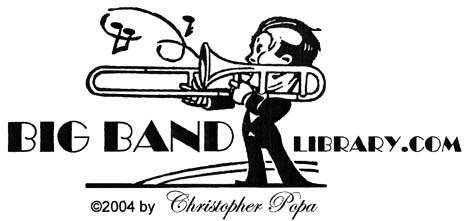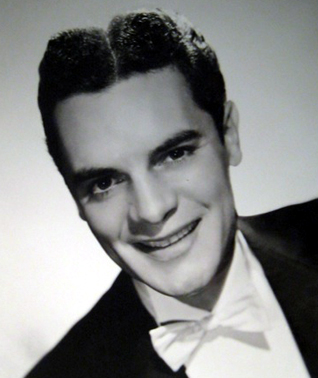
In between engagements at the Biltmore, Foster and his musicians appeared at the Mark Hopkins Hotel in San Francisco, the Chase in St. Louis, the Baker in Dallas, all - again - with network lines for radio broadcasts to the rest of the U.S. That's how he and his band became nationally-known.
vital stats:
given name Charles C. Fody
birth Aug. 26, 1912, Jeanette, PA
death Dec. 13, 2001
sister Gloria Foster, a singer
wife Delores Marshall, a singer, m.1953
daughter
military service U.S. Army, discharged Dec. 1943
hobbies golf
membership Local 47, American Federation of Musicians, Los Angeles, CA
residence Croydon Hotel, Chicago, IL [ 1940 ]; Encino, CA [ 2000 ]
Besides his own abilities, what helped "music in the Foster fashion" to remain popular into the 1970s was the fact that he had loyal, talented musicians working for him.
Most of the personnel in his band stuck around for a long time, including trumpeter Don Crawford; trombonist Dick Arant; lead alto saxophonist Bill Gee; tenor saxophonist Wayne Harden; another saxophonist, Jimmy Castle (who also sang); pianist Hal Pruden; bassist Stewart Strange; drummer Bob Simpson; and vocalists Dorothy Brandon or Dottie Dotson.
Their very first recordings were made as transcriptions for radio stations only, for Standard in 1939 and United in 1940.
Okeh Records signed them for commercial discs, and the band recorded a total of eight sides in October 1940 and June 1941, including their theme song, Oh, You Beautiful Doll, and I’ve Been Drafted (Now I’m Drafting You).
It was stated that in 1941-42 Foster and his orchestra traveled more than 50,000 miles in private automobiles and played in 28 states, mostly one-night stands or theaters, with a few steady gigs in hotels and ballrooms.
A special highlight for the band was working the Academy Awards ceremony held in Hollywood in 1941, and which named, among other honors, the best picture ("Rebecca"), best actor (James Stewart in "The Philadelphia Story," his only Oscar win), and best actress (Ginger Rogers as "Kitty Foyle").
Chicagoans, in particular, seemed to like hearing or dancing to Foster's music.
“Chuck’s band has already made a distinct hit,” critic Will Davidson observed while the group was performing in the Continental Room of the Stevens Hotel there in February 1942. "It’s a lively band without being boisterous,” he wrote.
In June of ‘42, the band added the nearby Oriental Theatre to its appearances. When they returned to the Oriental that December, former Chick Webb vocalist Ella Fitzgerald shared the bill. Then, on April 7, 1943, Foster opened an engagement at the Blackhawk Restaurant, also in Chicago's "Loop," and in August of that year, it was back to the Oriental, this time with the Mills Brothers vocal group.
Chuck Foster – In His Own Words
“The big, powerhouse bands were fine for colleges, for the kids around the bandstand, but for dancers
in the smaller rooms we lasted for weeks and came back every year.”
“We followed a regular system for all our performances. I chose the tunes and routined them for our
style. Hal Pruden did most of the actual arranging, and the contrast between the full-band sound and
Hal’s piano decorations gave us our style. Most of the hotels around the country wanted that style.”
“After the war big bands were dropping by the wayside because they were too expensive. We didn’t
have to price ourselves out of business, so we always had a job. I’ve never had to tell my band we
had nowhere to go next.”
After his brief service in the Army during World War II, Foster organized a new band in early 1944, opening at the Chanticleer nightclub in Baltimore, MD. They then headed back to the Blackhawk Restaurant in Chicago for, as was typical, several months.
A special anniversary celebration revived WGN’s “Midnight Flyers” radio program the night of May 13, 1946 at the Blackhawk. Foster and his orchestra were present, along with other notables including Martha Raye, Gypsy Rose Lee, Danny Thomas, and Dean Martin.
But, depending on the circumstances, the band was based in different locales.
When they operated out of New York City, they played, for example, the Hotel New Yorker in-town or the Steel Pier in nearby Atlantic City .
Starting in the ‘40s, he would take trips to the Hotel Peabody in Memphis, TN for a couple of lengthy engagements each year.
In 1953, Foster officially moved to the Chicago area, where he could continue to star at the Blackhawk, work the Aragon or Trianon ballrooms four or five months a year, and go elsewhere around the Midwest dance circuit.
He played a “battle of dance music” with Eddy Howard at the Aragon on July 31, 1955, and a similar “battle” was held between Foster and Ralph Marterie at the Aragon on June 17, 1956. (Howard’s and Marterie’s bands were also big Chicago favorites.)
Foster and his orchestra recorded for Mercury in 1946-48, on Vocalion in 1949, and around the late 1950s made what seems to have been his only 12" LP, “Chuck Foster at the Hotel Peabody Overlooking Old Man River,” for Philips International.
He decided to return to California in 1965, ready to retire. But a band was needed at Myron’s Ballroom in downtown Los Angeles, so he agreed to go there. He stayed for 8 years, stocking his playlists both with standards (Easter Parade, Avalon, Hindustan) and more-current pops (Born Free, King of the Road, Tijuana Taxi).
Even into the late 1970s and early 1980s, he was still willing to play for a gathering of dancers, whether in southern California or somewhere back East, like the Willowbrook or Holiday ballrooms in Chicago.
Foster always led an entertaining orchestra, including three trumpets, one trombone, three saxophones (not counting himself), and three rhythm. They played popular tunes at easy tempos, in a variety of rhythms, with clean phrasing and dynamics.
No wonder the public liked the band so much!
sources:
“Aragon Leader,” Chicago Daily Tribune, June 17, 1956, p.D8.
“Aragon Presents ‘Battle of Dance Bands’ Tonight,” Chicago Daily Tribune, Jul. 31, 1955,
p.F11.
“Chuck Foster’s Vocalist,” Chicago Daily Tribune, Feb. 15, 1942, p.E2.
Will Davidson, “Outstanding Bands Booked Into City’s Cafes and Hotels: Clubs Offering
Old Favorites and New Stars,” Chicago Daily Tribune, Feb. 22, 1942, p.G2.
---, “Price and Sophie Tucker to Brighten Café Shows: Chuck Foster Bringing Band to
Blackhawk,” Chicago Daily Tribune, Apr. 30, 1944, p.D5.
"Foster, Charles," dues payment card, Local 10, American Federation of Musicians,
Chicago, IL, 1940-49.
Charles Garrod, Chuck Foster and His Orchestra (Portland, OR: Metolius Music Company,
1992).
"Kennywood Keeps Chuck Foster's Band," Pittsburgh [ PA ] Post-Gazette, Jul 22, 1944.
Roger D. Kinkle, “Foster, Chuck,” in The Complete Encyclopedia of Popular Music and
Jazz 1900-1950, Volume 2: Biographies A Through K (New Rochelle, NY: Arlington
House Publishers, 1974), p.922
Hal Pruden, liner notes, “The Uncollected Chuck Foster Vol.2: 1938-39,” Hindsight
HSR-171, 1981.
Richard F. Sears, “Chuck Foster,” in V-Discs: A History and Discography (Westport, CT:
Greenwood Press, 1980), p.325.
Social Security Death Index.
“Songstress,” Chicago Daily Tribune, Apr. 7, 1943, p.20.
Irving Townsend, liner notes, “The Uncollected Chuck Foster and His Orchestra 1940,”
Hindsight HSR-115, 1977.
“Vaudeville: Oriental theater,” Chicago Daily Tribune, June 14, 1942, p.C2.
---, Chicago Daily Tribune, Dec. 20, 1942, p.D9.
Larry Wolters, “W-G-N to Revive Midnight Dance of 1930s: Chuck Foster’s Band on
Program Tonight,” Chicago Daily Tribune, May 13, 1946, p.30.
I would like to expand this tribute, if possible, with a new interview of someone who was important to Chuck Foster's life and career. Are you an alumnus of his band, a member of his family, or a collector who is knowledgeable about his accomplishments? Please contact me via e-mail
return to "Biographical Sketches" directory
go to Big Band Library homepage
The big bands are back
in a new and exciting way!
CHUCK FOSTER
"FOR THE DANCERS"
by Music Librarian CHRISTOPHER POPA
July 2009
His big break came a few years after he took over the leadership of a 10-piece band in California. He was a logical choice to be the new front man, since, besides playing saxophone and clarinet, he was handsome, sang a little, and could m.c. a floor show.
In 1939, Foster and his orchestra were hired for two weeks at the Biltmore Bowl, a hotel in Los Angeles, but wound up staying there seven months.
They went back in 1940 and ‘41, for a total of 18 months time! During that period, they made lots of network radio broadcasts.
